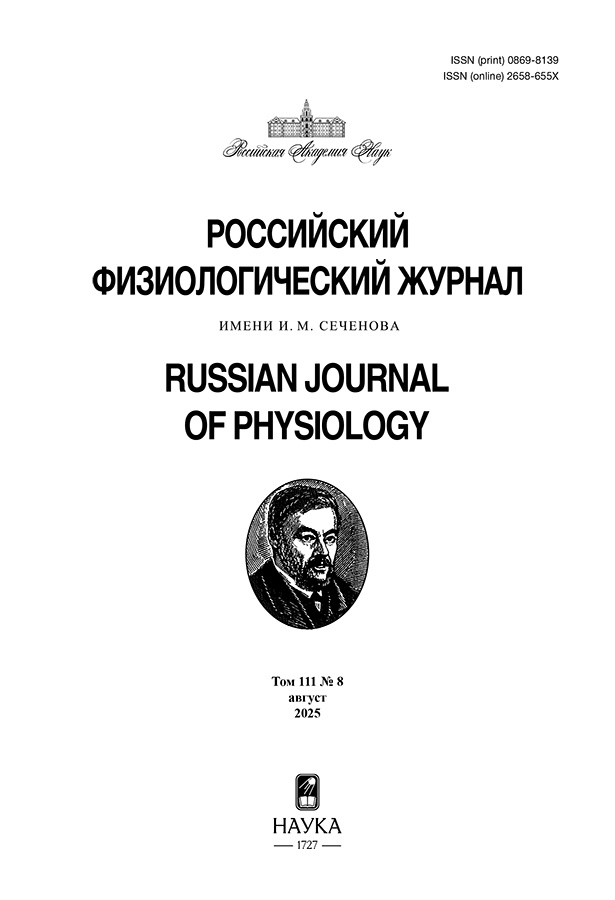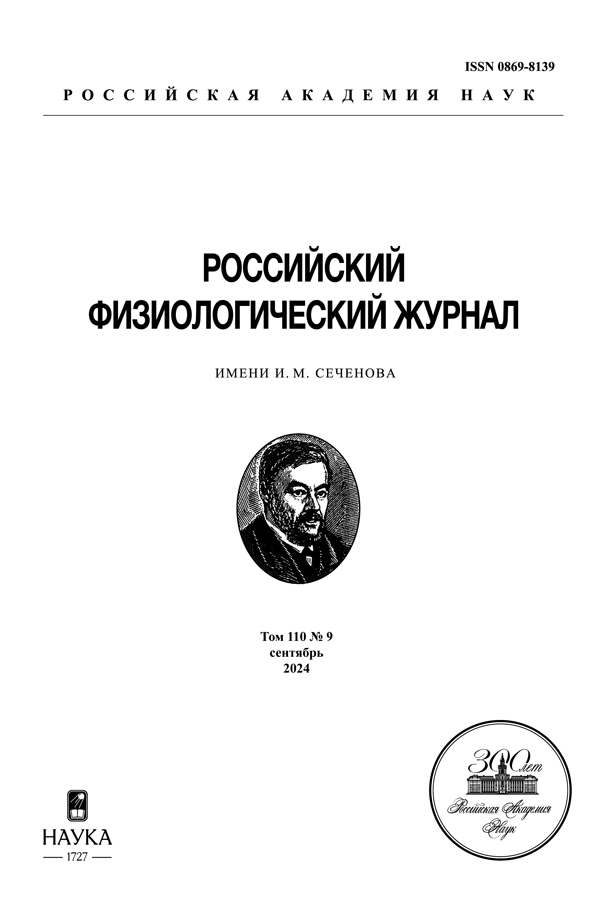D-серин снижает уровень внеклеточного серотонина в медиальной префронтальной коре и усиливает формирование реакции страха у крыс
- Авторы: Саульская Н.Б.1, Сусорова М.А.1
-
Учреждения:
- Институт физиологии им. И.П. Павлова Российской академии наук
- Выпуск: Том 110, № 9 (2024)
- Страницы: 1406-1419
- Раздел: ЭКСПЕРИМЕНТАЛЬНЫЕ СТАТЬИ
- URL: https://cardiosomatics.ru/0869-8139/article/view/651748
- DOI: https://doi.org/10.31857/S0869813924090095
- EDN: https://elibrary.ru/AJSTYG
- ID: 651748
Цитировать
Полный текст
Аннотация
D-серин является эндогенным агонистом глицинового сайта NMDA-рецепторов. Однако его вклад в организацию функций медиальной префронтальной коры (мПК) исследован мало. Целью работы было изучение участия D-серина в мПК в формировании и генерализации условной реакции страха (УРС – модель страха), а также в регуляции выброса серотонина в этой области. На крысах линии Спрег-Доули методами прижизненного внутримозгового диализа и ВЭЖХ показано, что введение D-серина (1мМ) в мПК снижает в ней базальный уровень внеклеточного серотонина и уменьшает на фоне такого снижения рост данного показателя во время выработки УРС (сочетание условного сигнала (CS+) с неизбегаемым болевым раздражением), но не в ходе дифференцировки 1 (предъявление дифференцировочного сигнала (CS–) без болевого раздражения). Введение в мПК D-серина уменьшало во время выработки УРС замирание животных на CS+ (показатель пассивного ожидания болевого раздражения) и увеличивало горизонтальную двигательную активность и число стоек (попытки избежать болевого раздражения). Такое фармакологическое воздействие приводило через сутки к усилению замирания на потенциально опасный CS+, но не на безопасный CS–. Полученные данные впервые свидетельствуют, что D-сериновая стимуляция мПК, снижающая выброс серотонина в этой области, усиливает в ходе выработки УРС активную стратегию поведения животных, направленную на избегание, и тормозит пассивную стратегию ожидания болевого раздражения. Это сопровождается усилением формирования и/или консолидации УРС, но не влияет на ее генерализацию.
Полный текст
Об авторах
Н. Б. Саульская
Институт физиологии им. И.П. Павлова Российской академии наук
Автор, ответственный за переписку.
Email: saulskayanb@infran.ru
Россия, Санкт-Петербург
М. А. Сусорова
Институт физиологии им. И.П. Павлова Российской академии наук
Email: saulskayanb@infran.ru
Россия, Санкт-Петербург
Список литературы
- Nishikawa T (2011) Analysis of free D-serine in mammals and its biological relevance. J Chromatogr B879: 3169–3183. https://doi.org/10.1016/j.jchromb.2011.08.030
- Umino A, Ishiwata S, Iwama H, Nishikawa T (2017) Evidence for tonic control by the GABAA receptor of extracellular D-Serine concentrations in the medial prefrontal cortex of rodents. Front Mol Neurosci 10: 271–338. https://doi.org/10.3389/fnmol.2017.00240
- Guercio GD, R Panizutti (2018) Potential and challenges for the clinical use of D-serine as a cognitive enhancer. Front Psychiatry 9: 14. https://doi.org/10.3389/fpsyt.2018.00014
- Wong JM, Folorunso OO, Barragan EV, Berciu C, Harvey TL, Coyle JT, Balu DT, Gray JA (2020) Postsynaptic Serine Racemase Regulates NMDA Receptor Function. J Neurosci 40: 9564–9575. https://doi.org/10.1523/JNEUROSCI.1525-20.2020
- Abreu DS, Gomes JI, Ribeiro FF, Diógenes MJ, Sebastião AM, Vaz SH (2023) Astrocytes control hippocampal synaptic plasticity through the vesicular-dependent release of D-Serine. Front Cell Neurosci 17: 1282841. https://doi.org/10.3389/fncel.2023.1282841
- Koh W, Park M, Chun YE, Lee J, Shim HS, Park MG, Kim S, Sa M, Joo J, Kang H, Oh S-J, Woo J, Chun H, Lee SE, Hong J, Feng J, Li Y, Ryu H, Cho J, Lee CJ (2021) Astrocytes render memory flexible by releasing D-serine and regulating NMDA receptor tone in the hippocampus. Biol Psychiatry 91: 740–752. https://doi.org/10.1016/j.biopsych.2021.10.012
- Krishnan KS, Billups B (2023) ASC Transporters mediate D-serine transport into astrocytes adjacent to synapses in the mouse brain. Biomolecules 13: 819. https://doi.org/10.3390/biom13050819
- Neame S, Safory H, Radzishevsky I, Wolosker H (2019) The NMDA receptor activation by D-serine and glycine is controlled by an astrocytic Phgdh-dependent serine shuttle. Proc Natl Acad Sci U S A 116: 20736–20742. https://doi.org/10.1073/pnas.1909458116
- Balu DT, Presti KT, Huang CCY, Muszynski K, Radzishevsky I, Wolosker H, Guffanti G, Ressler KJ, Coyle JT (2018) Serine racemase and D-serine in the amygdala are dynamically involved in fear learning. Biol Psychiatry 83: 273–283. https://doi.org/10.1016/j.biopsych.2017.08.012
- Inoue R, Ni X, Mori H (2023) Blockade of D-serine signaling and adult hippocampal neurogenesis attenuates remote contextual fear memory following multiple memory retrievals in male mice. Front Neurosci 16: 1030702. https://doi.org/10.3389/fnins.2022.1030702
- Inoue R, Talukdar G, Takao K, Miyakawa T, Mori H (2018) Dissociated role of D-serine in extinction during consolidation vs. reconsolidation of context conditioned fear. Front Mol Neurosci 11: 161. https://doi.org/10.3389/fnmol.2018.00161
- Xu W, Sudhof TC (2013) A neural circuit for memory specificity and generalization. Science 339: 1290–1295. https://doi.org/10.1126/science.1229534
- Pastor V, Medina JH (2021) Medial prefrontal cortical control of reward- and aversion-based behavioral output: Bottom-up modulation. Eur J Neurosci 53: 3039–3062. https://doi.org/10.1111/ejn.15168
- Peyron C, Petit JM, Rampon C, Jouvet M, Luppi PH (1998) Forebrain afferents to the rat dorsal raphe nucleus demonstrated by retrograde and anterograde tracing methods. Neuroscience 82: 443–468. https://doi.org/10.1016/S0306-4522(97)00268-6
- Maier SF (2015) Behavioral control blunts reactions to contemporaneous and future adverse events: medial prefrontal cortex plasticity and a corticostriatal network. Neurobiol Stress 1: 12–22. https://doi.org/10.1016/j.ynstr.2014.09.003
- Vanvossen AC, Portes MAM, Scoz-Silva R, Reichmann HB, Stern CAJ, Bertoglio LJ (2017) Newly acquired and reactivated contextual fear memories are more intense and prone to generalize after activation of prelimbic cortex NMDA receptors. Neurobiol Learn Mem 137: 154–162. https://doi.org/10.1016/j.nlm.2016.12.002
- Heroux NA, Horgan CJ, Stanton ME (2021) Prefrontal NMDA-receptor antagonism disrupts encoding or consolidation but not retrieval of incidental context learning. Behav Brain Res 405: 113175. https://doi.org/10.1016/j.bbr.2021.113175
- Vieira PA, Corches A, Lovelace JW, Westbrook KB, Mendoza M, Korzus E (2015) Prefrontal NMDA receptors expressed in excitatory neurons control fear discrimination and fear extinction. Neurobiol Learn Mem 119: 52–62. https://doi.org/10.1016/j.nlm.2014.12.012
- Saulskaya NB, Marchuk OE (2020) Inhibition of serotonin reuptake in the medial prefrontal cortex during acquisition of a conditioned reflex fear reaction promotes formation of generalized fear. Neurosci Behav Physiol 50: 432–438. https://doi.org/10.1007/s11055-020-00918-x
- Saul’skaya NB, Sudorgina PV (2016) Activity of the nitrergic system of the medial prefrontal cortex in rats with high and low levels of generalization of a conditioned reflex fear reaction. Neurosci Behav Physiol 46: 964–970. https://doi.org/10.1007/s11055-016-0338-2
- Saulskaya NB, Susorova MA, Trofimova NA (2023) Effect of nitric oxide synthase inhibitors on serotonin release in medial prefrontal cortex during conditioned fear response acquisition and generalization in rats. J Evol Biochem Physiol 59: 1700–1709. https://doi.org/10.1134/S0022093023050204
- Gilmartin MR, Kwapis JL, Helmstetter FJ (2013) NR2A- and NR2B-containing NMDA receptors in the prelimbic medial prefrontal cortex differentially mediate trace, delay, and contextual fear conditioning. Learn Mem 20: 290–294. https://doi.org/.1101/lm.053894.123
- Chen QY, Li XH, Zhuo M (2021) NMDA receptors and synaptic plasticity in the anterior cingulate cortex. Neuropharmacology 197: 108749. https://doi.org/10.1016/j.neuropharm.2021.108749
- Handford CE, Tan S, Lawrence AJ, Kim JH (2014) The effect of the mGlu5 negative allosteric modulator MTEP and NMDA receptor partial agonist D-cycloserine on Pavlovian conditioned fear. Int J Neuropsychopharmacol 17: 1521–1532. https://doi.org/10.1017/S1461145714000303
- Papouin T, Ladepeche L, Ruel J, Sacchi S, Labasque M, Hanini M, Groc L, Pollegioni L, Mothet J-P, Oliet SHR (2012) Synaptic and extrasynaptic NMDA receptors are gated by different endogenous coagonists. Cell 150: 633–664. https://doi.org/10.1016/j.cell.2012.06.029
- Otte D-M, Barcena de Arellano ML, Bilkei-Gorzo A, Albayram O, Imbeault S, Jeung H, Alferink J, Zimmer A (2013) Effects of Chronic D-Serine Elevation on Animal Models of Depression and Anxiety-Related Behavior. Plos One 8: e67131 https://doi.org/10.1371/journal.pone.0067131
- Bland ST, Hargrave D, Pepin JL, Amat J, Watkins LR, Maier SF (2003) Stressor controllability modulates stress-induced dopamine and serotonin efflux and morphine-induced serotonin efflux in the medial prefrontal cortex. Neuropsychopharmacology 28: 589–596. https://doi.org/10.1038/sj.npp.1300206
- Ceglia I, Carli M, Baviera M, Renoldi G, Calcagno E, Invernizzi RW (2004) The 5-HT2A receptor antagonist M100,907 prevents extracellular glutamate rising in response to NMDA receptor blockade in the mPFC. Neurochem J 91: 189–199. https://doi.org/10.1111/j.1471-4159.2004.02704.x
Дополнительные файлы



















